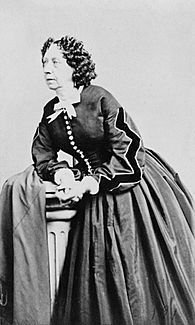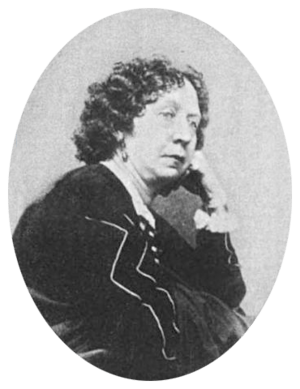Fanny Fern facts for kids
Quick facts for kids
Fanny Fern
|
|
|---|---|

Portrait of Fanny Fern
|
|
| Born | Sara Payson Willis July 9, 1811 Portland, Maine, US |
| Died | October 10, 1872 (aged 61) Manhattan, New York, US |
| Spouse |
Charles Harrington Eldredge
(m. 1837; Samuel P. Farrington
(m. 1849; div. 1853)James Parton
(m. 1856; |
| Relatives | Nathaniel Willis (grandfather) Nathaniel Willis (father) Nathaniel Parker Willis (brother) Richard Storrs Willis (brother) |
Fanny Fern (born Sara Payson Willis; July 9, 1811 – October 10, 1872) was an American writer. She wrote novels, children's books, funny stories, and newspaper columns. She was very popular from the 1850s to the 1870s.
People loved Fern's writing because it felt like she was talking directly to them. She also wrote about things that mattered to her readers, who were mostly middle-class women. By 1855, Fern was the highest-paid newspaper writer in the United States. She earned $100 every week for her column in the New York Ledger. One of her books, a collection of her columns published in 1853, sold 70,000 copies in its first year. Her most famous book is the novel Ruth Hall (1854). This book is a fictional story based on her own life. Today, it is often studied by people interested in women's rights and literature.
Contents
About Fanny Fern
Her Early Life
Sara Payson Willis was born in Portland, Maine. Her father, Nathaniel Willis, owned a newspaper. Sara was the fifth of nine children. Her older brother, Nathaniel Parker Willis, became a well-known journalist. Her younger brother, Richard Storrs Willis, became a musician. He wrote the tune for the famous Christmas song "It Came Upon the Midnight Clear".
Sara's father wanted to name her after a minister's mother, Grata Payson. But the minister said his mother didn't like that name. So, her family decided to call her Sara instead.
Sara's last name changed several times during her life. This was because of her three marriages and the pen name she chose. She picked "Fanny Fern" because it reminded her of her childhood. She felt this name fit her better, and soon most of her friends and family called her "Fanny."
Sara went to a boarding school in Hartford, Connecticut, run by Catharine Beecher. Beecher once said Sara was one of her "worst-behaved girls," but also that she "loved her the best." While at school, Sara had her first writing success. Her stories were published in the local newspaper. She also attended the Saugus Female Seminary. After school, she wrote and edited articles for her father's Christian newspapers, The Puritan Recorder and The Youth's Companion.
Becoming a Professional Writer
In 1837, Sara married Charles Harrington Eldredge, who was a banker. They had three daughters. Sadly, Sara faced many losses in a short time. Her mother and younger sister died in 1844. In 1845, her oldest daughter died from a brain fever (meningitis). Soon after, her husband Charles died from typhoid fever.
These sad events left Sara with very little money. Her father and her husband's family did not help her much. Her brother, N.P. Willis, did not help at all. She struggled to support her two young daughters. Her father encouraged her to marry again.
In 1849, Sara married Samuel P. Farrington, a merchant. But this marriage was a mistake. Farrington was very jealous, so Sara left him in 1851. This caused a scandal for her family, and they divorced two years later.
In November 1851, Sara published her first article, "The Governess," in the Olive Branch newspaper. She then wrote some funny stories for that paper and the True Flag. Soon, she started using the pen name "Fanny Fern" for all her articles. By 1852, she was on her own with two daughters to support, so she began writing seriously. She sent her work to her brother Nathaniel, who owned a magazine. But he refused to publish her, saying her writing wouldn't sell outside Boston. He was wrong! Newspapers in New York and other cities soon started printing Fanny Fern's "witty and irreverent columns."
In the summer of 1852, Fanny Fern was hired by publisher Oliver Dyer. He paid her twice as much to write a regular column only for his New York newspaper, Musical World and Times. She was the first woman to have a regular column like this. The next year, Dyer helped her find a publisher for her first two books. These were Fern Leaves from Fanny's Portfolio (1853), a collection of her more emotional columns, and Little Ferns for Fanny's Little Friends (1853), a children's book. She had to tell the publishers her real name, which was still Farrington. She didn't like that name, so she tried to keep it a secret. Her first book, Fern Leaves, sold an amazing 70,000 copies in its first year. This was a huge number for that time!
A Top Columnist
James Parton, a writer and historian, was impressed by Fanny Fern's work. He edited Home Journal, a magazine owned by Fern's brother Nathaniel. Parton published her columns and invited her to New York City. When her brother found out, he told Parton not to publish any more of Fern's work. Parton was so upset that he quit his job as editor.
Fern's first book, Fern Leaves (1853), was a huge success. It sold 46,000 copies in the first four months. She earned enough money from royalties (ten cents per copy) to buy a house in Brooklyn and live comfortably. Just three years into her writing career, in 1855, she was earning $100 a week for her column in the New York Ledger. This made her the highest-paid columnist in the United States. Her first regular column in the Ledger appeared on January 5, 1856. She wrote a column every week without missing a single one until October 12, 1872, just two days after she died.
Fern wrote two novels. Her first, Ruth Hall (1854), was based on her own life. It told about her happy years with her first husband, the poverty she faced after he died, and how her male relatives didn't help her. It also showed her struggle to become financially independent as a journalist. Many characters in the book were based on real people in her life. She used the book to get back at those who had treated her badly when she needed help most. This included her father, her in-laws, her brother N.P. Willis, and two newspaper editors.
When people found out that Fern was the author and that the book was about her family, some critics were shocked. They thought it was scandalous that she attacked her own relatives. They said she didn't show enough respect for her family and lacked "womanly gentleness." However, the book also received good reviews. The famous author Nathaniel Hawthorne praised the novel. He said he "enjoyed it a great deal. The woman writes as if the devil was in her, and that is the only condition in which a woman ever writes anything worth reading."
After the criticism, Fern tried to make her second novel, Rose Clark, less about her own life. This book had a sweet and gentle main character. But it also included a side character who made a bad marriage for convenience. This was something Fern had regretted in her own life.
Later Life and Legacy
Sara Willis and James Parton married in 1856. She was 45 and already a successful writer. They lived in New York City with Ellen, one of her two surviving daughters. They also raised Ethel, her granddaughter, who became an orphan after her mother Grace died in 1862.
In 1859, Fern bought a brownstone house in Manhattan. She and Parton lived there for 13 years until her death.
Fern continued writing her weekly column for the Ledger for the rest of her life. She supported suffrage, which was the movement for women's right to vote. In 1868, she helped start Sorosis. This was New York City's first club for women writers and artists. It was formed after women were not allowed to attend a dinner honoring author Charles Dickens at an all-male club.
Fanny Fern battled cancer for six years. She died on October 10, 1872. She is buried in Mount Auburn Cemetery in Cambridge, Massachusetts, next to her first husband. Her gravestone simply says "Fanny Fern." After she died, her husband James Parton published a book about her life called Fanny Fern: A Memorial Volume (1874).
Fanny Fern's Books
Fanny Fern wrote two novels, one short novel, six collections of her newspaper columns, and three books for children.
Column collections
- Fern Leaves from Fanny's Portfolio (1853)
- Fern Leaves, second series (1854)
- Fresh Leaves (1857)
- Folly As It Flies (1868)
- Ginger-Snaps (1870)
- Caper-Sauce (1872)
Novels
- Ruth Hall (1854)
- Fanny Ford (1855)
- Rose Clark (1856)
Children's books
- Little Ferns for Fanny's Little Friends (1853)
- The Play-Day Book (1857)
- The New Story Book for Children (1864)
Her Impact
- Fanny Fern is believed to have created the saying, "The way to a man's heart is through his stomach."
- Henry D. Butler dedicated his 1858 book The Family Aquarium to "the gifted litterateuse whose nom de plume is 'Fanny Fern'".
- Fern's granddaughter, Ethel Grace Thompson Parton, became a writer for The Youth's Companion. This was the same periodical her great-uncle, Nathaniel Willis, had founded.
- In 2005, an opera about Fern called A.F.R.A.I.D. (American Females for Righteousness Abasement Ignorance & Docillity) was performed for the first time.
Images for kids



